The succulent plant sedum, or sedum, is a member of the Tolstyankovy family. In the people, such a succulent is also called feverish or hernial grass. Under natural conditions, it can still be found in Eurasia, Africa, South and North America in meadows and dry slopes. The name sedum comes from the word "sedo", which translates from Latin as "to calm down", this is due to the fact that foliage in some species was used as an anesthetic. There is a myth about how Telehos, the son of Hercules, healed the severe wound that Achilles inflicted on him with a spear with such a plant. To date, more than 300 species of such a plant are known, while only about 100 species are cultivated, and there are still a large number of hybrids and varieties. Among them there are garden plants (for example, sedum large), and there are indoor plants (for example, Morgan's sedum).
Content
Brief description of cultivation
- Landing... Sowing sedum seeds for seedlings is carried out in March or April, transplanting seedlings into open soil is carried out in the last days of May.
- Bloom... In summer and autumn.
- Illumination... Penumbra, diffused or bright sunlight.
- Priming... Anyone will do, even stony ones, but organic fertilizer must be applied to it before planting.
- Watering... As a rule, only natural precipitation is enough for stonecrop, but with prolonged drought it must be watered systematically.
- Fertilizer... In spring and autumn, stonecrop is fed with a solution of organic matter or a complex mineral fertilizer (infusion of mullein (1:10) or bird droppings (1:20)). Experts do not recommend feeding the plant with fresh manure.
- Reproduction... By dividing the bush and cuttings, and less often by seeds.
- Harmful insects... Weevils, aphids, thrips and sawfly caterpillars.
- Diseases... Fungal rot.
- Properties... Some species of such a plant have medicinal properties, they are distinguished by anti-inflammatory, stimulating, wound-healing, antitumor, regenerating, hemostatic and tonic effect.
Stonecrop features
Sedum is a herbaceous succulent plant that is a perennial or biennial, it is represented by shrubs or dwarf shrubs. The leaf plates are alternately fleshy, solid and sessile, they can be opposite or whorled, they can also have a different shape, size and color.Lateral or apical inflorescences can have an umbellate, corymbose or racemose shape, they include bisexual star-shaped flowers of various colors. Flowering is observed in summer or autumn. Sedum is an excellent honey plant that attracts bees to the garden. At home, as a rule, tropical sedum is cultivated, while perennial frost-resistant species with erect or creeping shoots are grown in garden plots. All species are drought tolerant and light-requiring, but they thrive in light shade. Sedum is a relative of Kalanchoe, young, echeveria and spotted petals.
Growing stonecrop from seeds
Sowing
In the open field, sedum can be grown from seed through seedlings. Seeds are sown in March or April, the distance between them should be from 40 to 50 mm. For this, containers or boxes are used, which must be filled with a soil mixture consisting of sand and garden soil, they are covered with coarse sand on top. Crops must be carefully moistened from a spray bottle, then covered with film or glass from above, and then removed to the lower shelf of the refrigerator for stratification, while the air temperature should be from 0 to 5 degrees. As long as the crops are on the shelf of the refrigerator, they must be ventilated every day, while the accumulated condensate must be removed from the surface of the shelter. The soil mixture should be constantly slightly damp. After half a month, the crops should be placed on the windowsill, while the required air temperature should be about 18-20 degrees. The first seedlings should appear 15-30 days later, before this happens, the crops must be systematically ventilated, condensation must be removed from the surface of the shelter, and the soil mixture must be moistened from the sprayer immediately after it dries.
Sowing seeds for seedlings, if desired, can be carried out before winter. This should be done in the same way as described above, but the crops are not removed to the refrigerator shelf, but they are transferred to the greenhouse or buried in the ground, under these conditions the seeds will undergo natural stratification. Crops should be brought into the room in April for germination.
Growing seedlings
The seedlings of such a plant are very small. After the emergence of seedlings is massive, the shelter is removed from the container. The picking of plants into individual small pots is carried out during the formation of their second true leaf plate. It is very simple to care for the seedlings, for this it is necessary to systematically water it and gently loosen the surface of the soil mixture. When 7 days remain before transplanting into open soil, they begin to harden it, for this, the plants are transferred to the street every day, while the duration of such a procedure must be increased gradually.
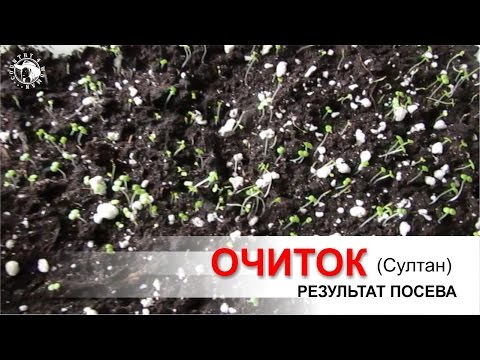

Watch this video on YouTube
Planting stonecrop in open ground
When to plant sedum in the ground
Planting stonecrop seedlings in open soil is carried out in the last days of May after the threat of return spring frosts is over. It is a picky plant, so you can choose a sunny area and partial shade for growing it, but it grows best in the light. The site should be open and located away from deciduous shrubs and trees, the fact is that if the bushes are covered with foliage in the fall, then with the onset of spring he will not have the strength to break through it.
Landing rules
This plant is also unpretentious to the composition of the soil, it can be grown even on rocky soil, but in order for the bushes to be very effective, organic fertilizers (compost or humus) must be added to the ground before planting. Planting holes must be made in the soil, while the distance between them should be about 0.2 m, then the plants are transplanted into them.The planted seedlings need abundant watering. The flowering of bushes grown from seeds begins at 2–3 years.
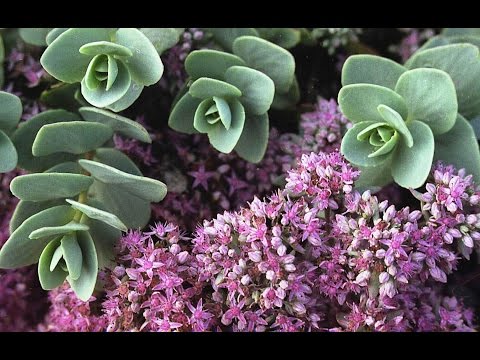

Watch this video on YouTube
Caring for stonecrop in the garden
When growing sedum in your garden, you need to weed it quite often. However, there is a kind of caustic soda that is able to get rid of all weeds by itself, and therefore it is often used to frame alpine slides and flower beds. But almost all other species are capable of suffering from weeds, so they must be removed in a timely manner. Watering is carried out only during a prolonged drought. The growth of the stems must be monitored, and therefore they should be shortened in a timely manner, not allowing them to grow. In order to preserve the decorative effect of the bushes, inflorescences and foliage that have begun to fade must be removed immediately, while all green stems must be cut out from bushes with multi-colored shoots. In spring and autumn, sedum is fed with complex mineral fertilizer or liquid organic fertilizer (solution of bird droppings (1:20) or infusion of mullein (1:10)). It is impossible to feed this plant with fresh manure.
Stonecrop propagation
How to propagate this plant by seed was discussed at the beginning of this article. Sedum can be grown from seeds collected by yourself, but it is highly likely that these plants will not inherit the varietal characteristics of the parent plant. Generative (seed) propagation is recommended only for initial cultivation, and it is also suitable for breeding new varieties. To propagate varietal bushes, it is best to use the vegetative method (dividing the bush or cuttings).
Ground cover species can be grafted before or after the shrubs bloom. The stalk is cut from the stem, while its length should be about the size of a finger, all the lower leaf plates are cut off from it, and then planted in a loose soil mixture for rooting, while at least 1 node must be buried in the substrate. After rooting, the cutting is transplanted to a permanent place. In springtime, trimmed cuttings should be immediately planted in open soil. In the fall, several stems are cut off, and then they are put into a vase, like a bouquet, while watching the water so that it does not stagnate, it should be systematically replaced. By the onset of the spring period, all the cuttings should have roots, after which they can be planted in open ground. If the cuttings are rooted in the middle of winter, they will need to be planted in separate pots, and in the spring they are transplanted by transferring them into open ground to a permanent place.
It should also be remembered that you can root any part of the stem or the entire shoot right on the spot. The soil surface located directly under the stems must be cleaned of weeds, then fertilizers are applied to the ground, leveled and tamped. After that, several stems are pressed to the surface of the prepared area, which are covered from above with a soil mixture consisting of sand and garden soil, which is then pressed a little. With this method of propagation, 7-10 cuttings out of 10 take root.
Vigorous bushes, as well as those plants that are older than 4–5 years, can be propagated by division. To do this, at the beginning of the spring period, the sedum must be removed from the soil, all the soil is removed from its rhizome, after which the bush is divided into several parts, while it must be taken into account that both buds and roots must be present on each cut. Places of cuts will need to be treated with a fungicidal preparation, after which parts of the bush are removed to a cool shaded place for several hours, where they should dry out. After this, the delenki are planted immediately in a permanent place.


Watch this video on YouTube
Transfer
A bush can be grown in the same place for no more than 5 years, after which it must be rejuvenated.To begin with, all the old stems are cut off from him, then fresh soil and fertilizers are poured under the root, but if there is such an opportunity, it is better to transplant sedum. As a rule, during transplanting a bush, it is divided into parts, how to do this is described in detail above.
Diseases and pests
This culture is highly resistant to diseases and harmful insects. However, problems can also arise with it, for example, if watering is excessively frequent and abundant, or the summer period is rather cool and rainy. In this case, the bush may be affected by fungal diseases. The first sign that the bush is sick is the appearance of dark spots on its leaf plates. Cope with the disease can be treated with a fungicidal preparation. Those plants that are very strongly affected are recommended to be removed from the soil and destroyed.
Aphids, sawfly caterpillars, weevils and thrips can settle on sedum. To get rid of weevils, they must be collected by hand, for this, white material is spread under the bush and at night, by the light of a flashlight, pests are shaken off the plant, after which they must be destroyed. In this case, false caterpillars, aphids and thrips can be destroyed by spraying the plant with an insectoacaricide solution, for example, Aktellik.
Sedum after flowering
Seed collection
Before proceeding with the collection of stonecrop seeds, one must take into account that the plants obtained from them are not able to preserve the varietal characteristics of the parent plant. You also need to remember that the flowering of this plant continues until severe frosts, and in winter it leaves with green foliage, which will also make it very difficult to collect seeds. And you also need to remember that sedum is very easily propagated by cuttings or dividing the bush.
How to prepare for wintering
After the first real frosts are left behind, it is recommended to cut the bush, while trimming should rise above the soil surface, the length of which should not exceed 30–40 mm. These scraps must be covered with a layer of soil. If desired, the cut stems can be rooted (see above), and in springtime they can be planted in a permanent place in open ground. If you like the look of sedum covered with snow, then you don't need to cut it off. However, it should be borne in mind that with the onset of spring, the bush should still be cut off, since it will lose its attractiveness.
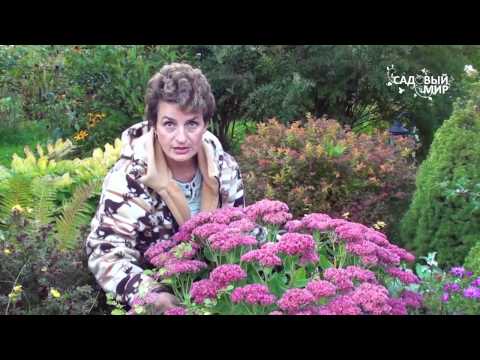

Watch this video on YouTube
Types and varieties of stonecrop with photos and names
All types of sedum are divided into ground cover plants, which are sedum (Sedum), and sedum (Hylotelephium), which are taller and they are allocated in the subgenus of sedum. The most popular among gardeners are the sedum types described below.
Sedum large (Sedum telephium)
Or sedum, or telephium sedum (Hylotelephium triphyllum), or purple sedum (Sedum purpureum), or leguminous grass, or crow tallow, or live grass, or hare cabbage.
This perennial is a melliferous plant, which reaches a height of 25-30 centimeters. Its shoots are erect and thick. Oval sessile flat leaf plates can be opposite or alternately located, their edge is serrated. Flowering is observed from mid to late summer. At the tops of the shoots, lush corymbose paniculate inflorescences are formed, consisting of yellow-green or red flowers. Under natural conditions, such a plant can be found in the temperate climate of Europe and Asia, while it prefers to grow in clearings, in pine forests, on forest edges, in bushes and on the slopes of ravines. This type is medicinal; in alternative medicine, its foliage is used as a tonic and strengthening agent. This type has several subspecies:
- common legume - flowers are dark purple;
- ordinary big - flowers are white-green or white-yellow;
- ordinary ordinary - this differs from the ordinary large subspecies in the form of leaf plates, which taper towards the base;
- common Ruprecht - color of inflorescences is white-cream.
As a result of the work of breeders, a large number of varieties of this species have appeared and almost all of them are quite popular in culture. The most popular varieties are:
- Matron... The height of a powerful bush is about 0.6 m. Large greenish-blue leaf plates grow on dark purple shoots; over time, their edge turns red. The flowers are pinkish.
- black Jack... The height of the bush is about 0.4 m, its foliage is purple-blue. The dense inflorescences include pink flowers.
- Linda Windsor... The color of erect shoots is maroon, the foliage is dark red, and the flowers are ruby-colored.
- Strawberry and Cream... The height of such a hybrid plant is about 0.4 m. The leaf plates are green, the buds are pinkish-red, and the flowers are cream, which makes the inflorescences look two-colored.
- Picolette... The height of the compact bush is about 0.3 m, it is decorated with small bronze-red leaf plates with a metallic sheen. The dense inflorescences include pink flowers.
Among gardeners, varieties such as Ruby Glow, Rosie Glow, Bon-Bon, Vera Jamieson, Green Expectations, Gooseberry Full, Hab Gray, Crazy Raffles, Xenox, etc. are very popular.
White sedum (Sedum album), or soap dish
Either a bee, or a six-weekday, or living grass, or God's color.
Under natural conditions, this species can be found in the Caucasus, Asia Minor, Russia, Western Europe and North Africa. This species was called white stonecrop due to the fact that its fragrant flowers are white, they are part of paniculate inflorescences, which consist of several branches. Such an evergreen perennial plant forms a mat, the height of which is about 50 mm, its vegetative branches are short, and plump, twisted oval-elliptical leaf plates, which are about 10 centimeters long, grow on them. This species has several varieties:
- white small-flowered - inflorescences in this shape are white, while spherical green leaf plates never turn red;
- white wall - it is a lush blooming form with pink inflorescences and bronze or purple leaf plates;
- white wall kristatum - the overgrown tips of the stems have a dense covering, consisting of leaf plates.
The most popular varieties:
- Coral Carpet... The height of the bush is only about 50 mm. Its pale red foliage turns red in autumn.
- France... This tall plant is adorned with long green leaf plates, while under bright sunlight they turn pink over time.
- Laconicum... The tall bush is adorned with lush, sessile green foliage, which in some cases can turn red.
Sedum acre
Either lamb, or goose soap, or wild pepper, or feverish grass, or younger, or pimple, or blush, or guillemot, or vigorous.
In nature, this species is found in Western Siberia, Asia Minor, the European part of Russia, the Caucasus and North America. If the juice of such a plant gets on the skin, then ulcers can form on it, and the specific name is associated with this. The height of the bush is about 10 centimeters, the shoots are branched and rounded. Bare fleshy alternate leaf plates are green and about 0.6 cm long. The foliage does not fly off the bush even in winter. Semi-umbellate inflorescences consist of yellow-golden flowers, which reach about 15 mm in diameter. This species has many different forms:
- Aureum - in this form, the tips of the stems are pale yellow in spring;
- Minus - this is a very short form with lush small foliage;
- Elegans - a low-growing bush is decorated with twisted leaf plates of a variegated color.
False sedum (Sedum spurium)
In nature, this species grows in subalpine meadows, and also on the rocky slopes of Turkey, the Caucasus and Iran. Such a frost-resistant perennial plant has long creeping rhizomes. Shoots can be ascending or creeping. The opposite fleshy leaf plates of a dark green color are ovoid-wedge-shaped, while they are thick-toothed or crenate along the edge. The composition of the lush shields includes flowers of purple or pink color. This plant has been cultivated since 1816. The following varieties are most popular:
- Album - the color of the flowers is white, and the foliage is green;
- Bronze Carpet - the color of the inflorescences is pink, the leaf plates become bronze by autumn;
- Ruby Mantle - the inflorescences are purple, and the foliage is dark red;
- Shobuser Bluetooth - in spring, the bush adorns foliage with a red border, while in the fall it turns red.
Gardeners also cultivate varieties such as: Erd Bluet, Fulda Glut, Purpureppih, Koktsineum, Roseum, Salmoneum, etc.
Sedum prominent (Hylotelephium spectabile), or sedum prominent
The homeland of this species is Japan, North Korea and Northeast China. The height of the bush is about 50 cm, while its rhizome is tuberous and thickened. Erect shoots are decorated with large bare sessile leaf plates of a green-blue color, their shape is oval or spatulate, and the edge is jagged. The diameter of the semi-umbilical inflorescences is about 15 centimeters, they consist of flowers up to 10 mm in diameter, which have a pinkish-lilac or carmine-purple color. In Asia, such a plant has been cultivated for a long time, and in Europe since 1853, a large number of varieties have been cultivated by gardeners:
- Iceberg - the height of the bush is about 0.35 m, the inflorescences are white;
- Diamond - This is a relatively old variety with inflorescences consisting of pink flowers with anthers of a rich color and rich pink carpels;
- Septemberglut - large inflorescences consist of small dark pink flowers;
- Stardust, Snow Queen - inflorescences in such varieties are white;
- Meteor, Carmen - these 2 species are similar to each other, and they have purple flowers;
- Autumn Faye - the height of the bush is about 50 cm, the leaf plates are grayish-green, and the flowers are copper-colored;
- Neon - a bush about 0.35 m high is decorated with large inflorescences of a rich pink color.
Even in culture, stonecrops such as: spatulate, Alberta, pale yellow, hybrid, thick-leaved, Spanish, Kamchatka, Kuril, carneum, linear, Lydian, vine-shaped, Middendorf, multi-stemmed, annual, Oregon, bent-out, ovipose, divergent , Rustic, blue, opposite-leaved, dark red, thick-branched, thin, slender, Troll, narrow-leaved, Forster, six-rowed and subulate.
Most often grown such types of sedum, as: white-pink, anakampseros, blanching, viviparous, Zibolda, Caucasian, false-representative, whorled, backyard, Tatarinova, poplar, Ussuri and Eversa.


Watch this video on YouTube
Stonecrop properties: benefits and harms
Medicinal properties of stonecrop
In alternative medicine, such medicinal types of sedum are used as: prominent, common (large, purple) and caustic.
Common sedum has anti-inflammatory, stimulating, wound healing, antitumor, regenerating, hemostatic and tonic effect. This type is considered a strong biogenic stimulant, which in its activity exceeds aloe, while it acts on the body very gently and does not cause unwanted side effects.
Stonecrop is used as an adjuvant in the treatment of pneumonia, bronchitis, hepatitis, non-healing wounds and trophic ulcers, impotence, nervous disorders, kidney and bladder diseases, and oncological diseases.
And the type of sedum is used for anemia, epilepsy, diseases of the gastrointestinal tract, ischemia and pulmonary insufficiency. It helps to stop bleeding, relieve inflammation and pain, neutralize the action of microbes and bacteria, discharge phlegm, remove toxins from the body, restore joint mobility, lower blood pressure, calm the nervous system, heal wounds, dilate blood vessels, stimulate the endocrine glands, lower cholesterol and strengthening the immune system.
The type of sedum is characterized by an irritating and diuretic effect. It is used in the treatment of malaria, to enhance intestinal motility, increase blood pressure, heal wounds, burns and ulcers, treat catarrh of the upper respiratory tract, dropsy, anemia, jaundice, tuberculosis of the skin in children. Means made on the basis of caustic sedum have an analgesic effect.


Watch this video on YouTube
Contraindications
Only the caustic stonecrop has contraindications, because its juice has an irritating effect. Preparations made from such a plant should not be used for hypertensive patients during pregnancy. When used externally, there may be burning, irritation or redness of the skin, and if its juice is taken internally, it can cause nausea. In this regard, before using sedum for treatment, it is necessary to consult with your doctor.

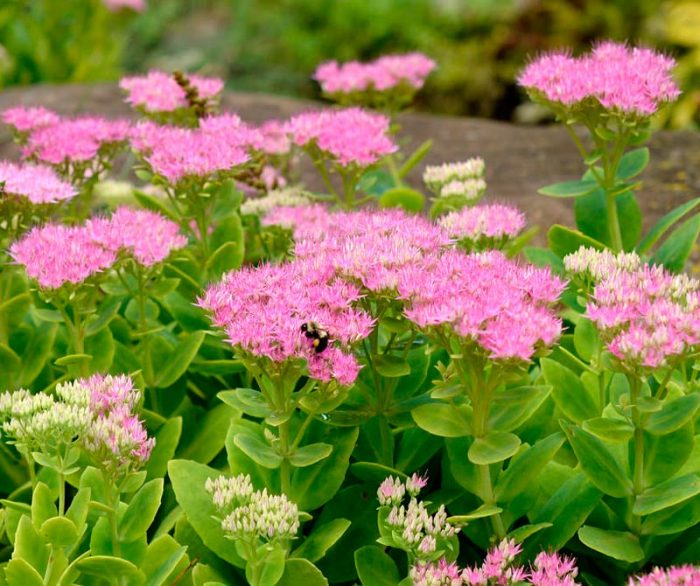
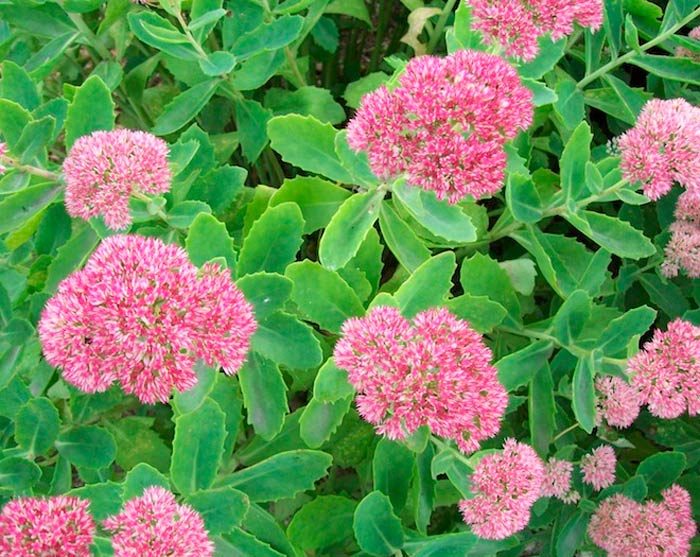
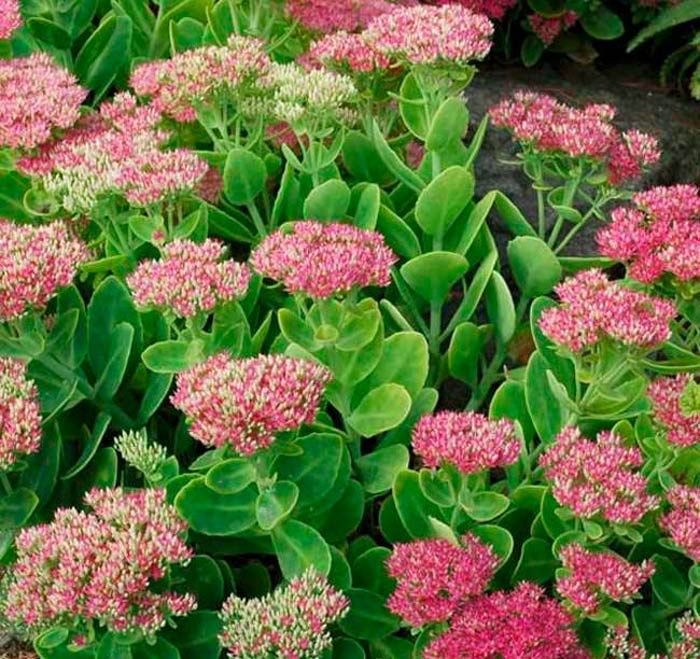
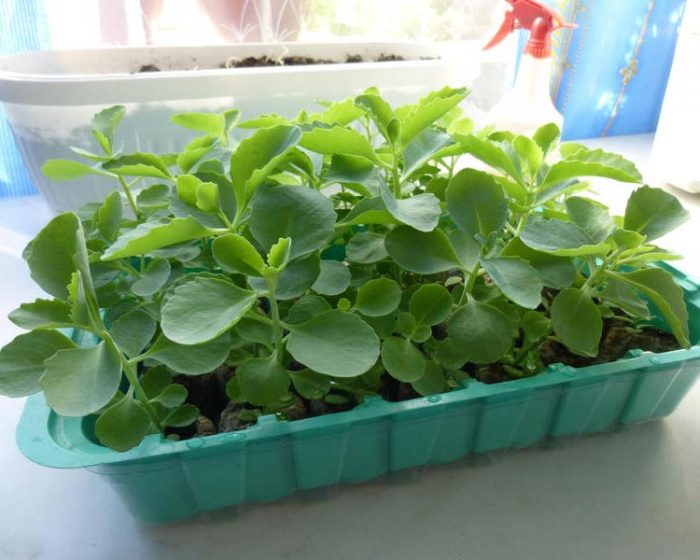
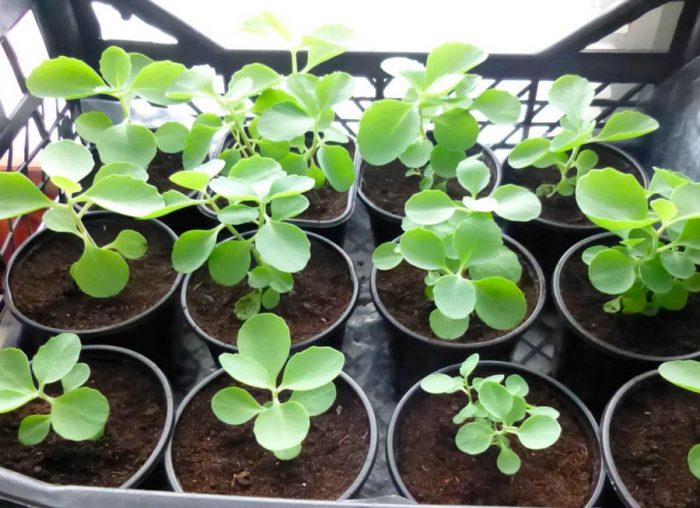
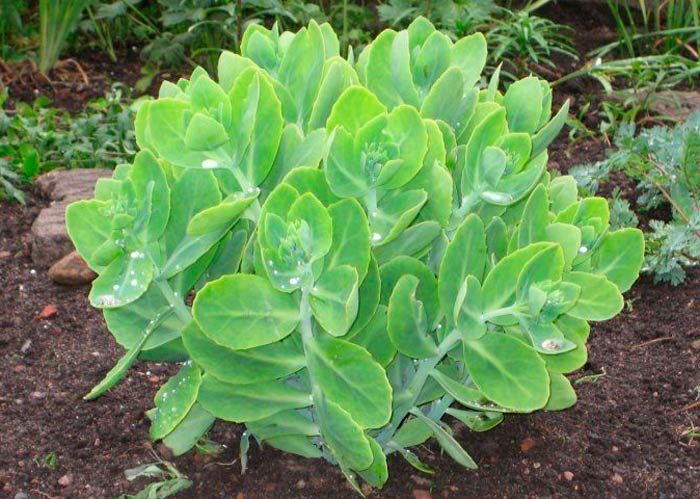
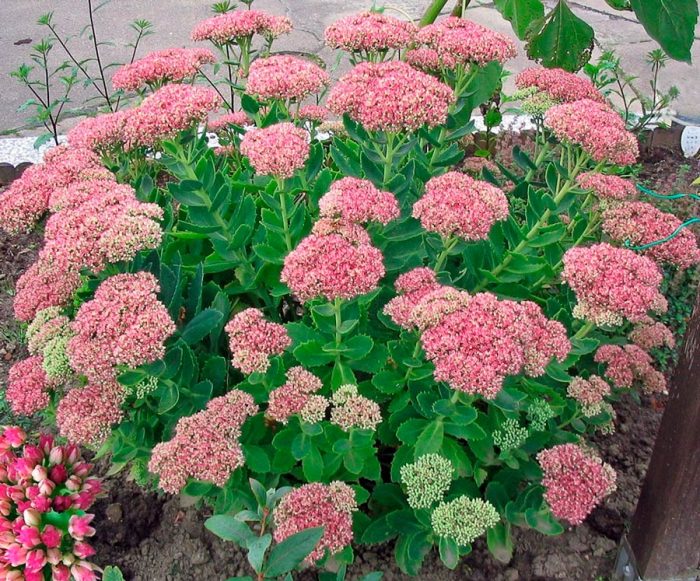
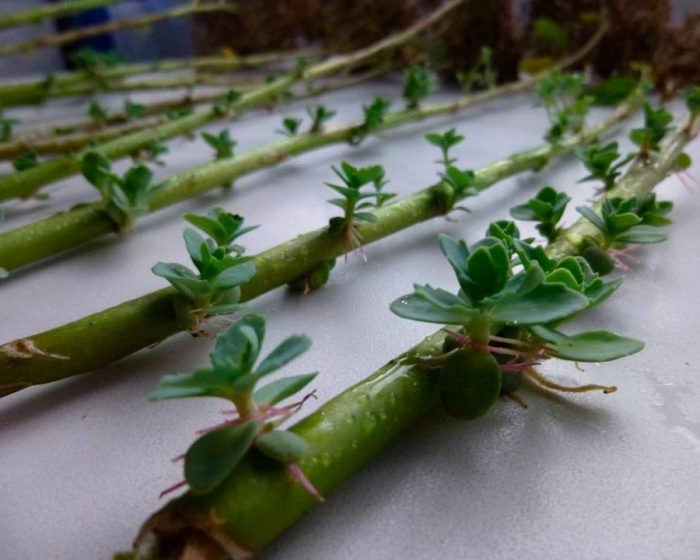
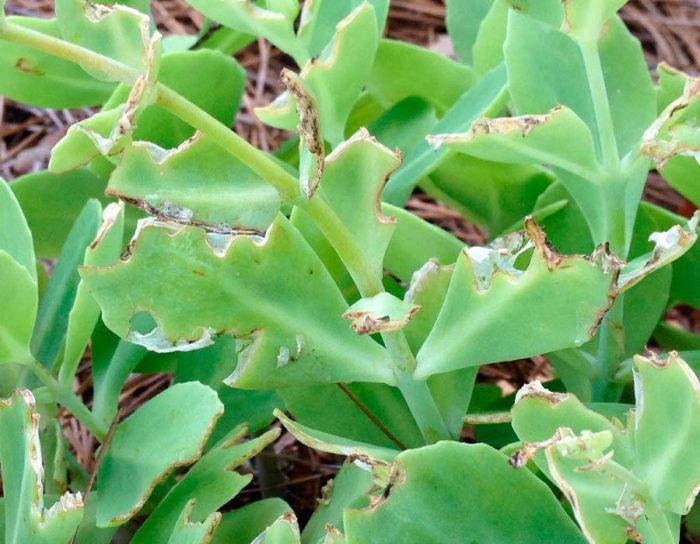
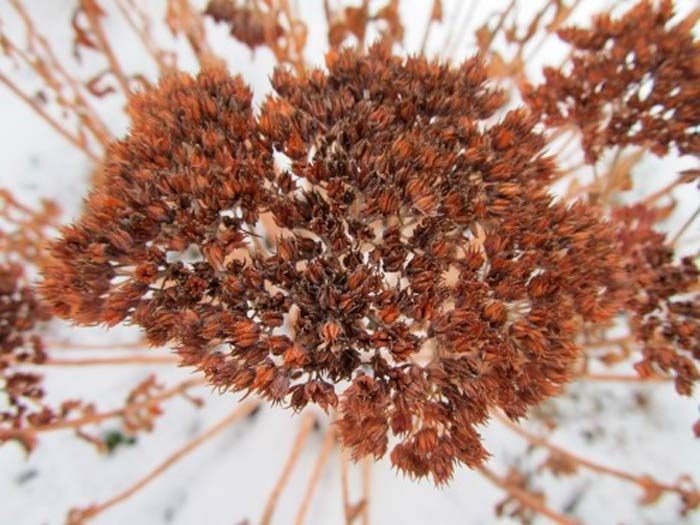
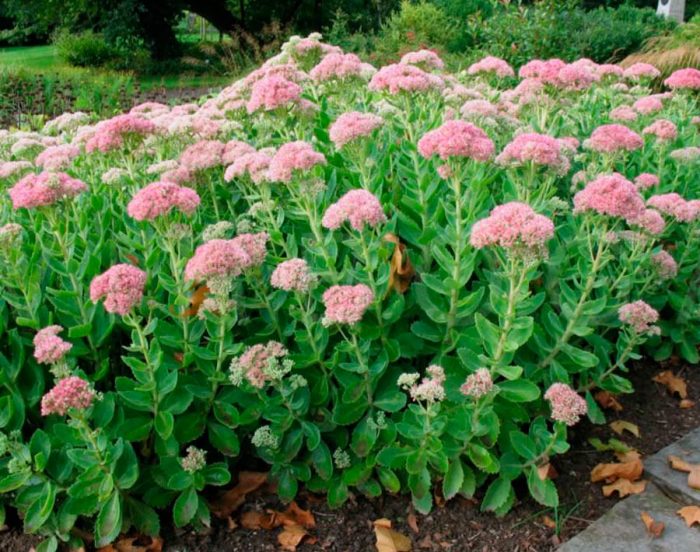

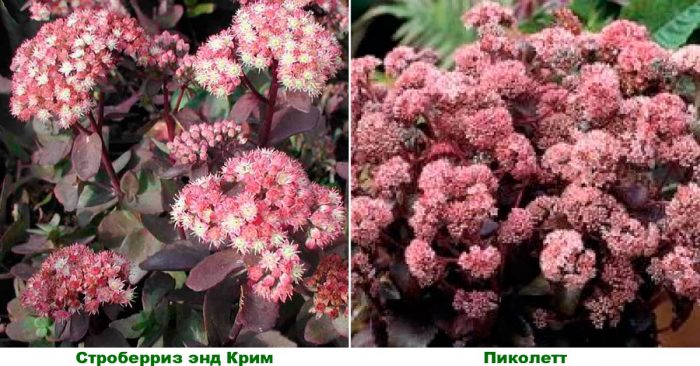
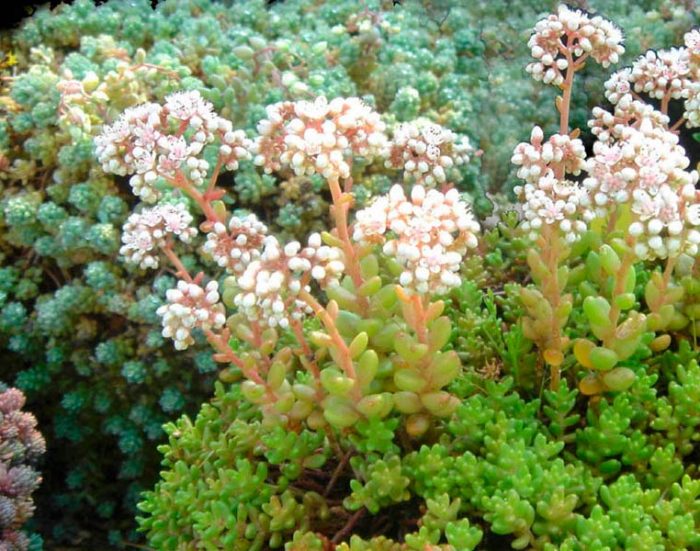
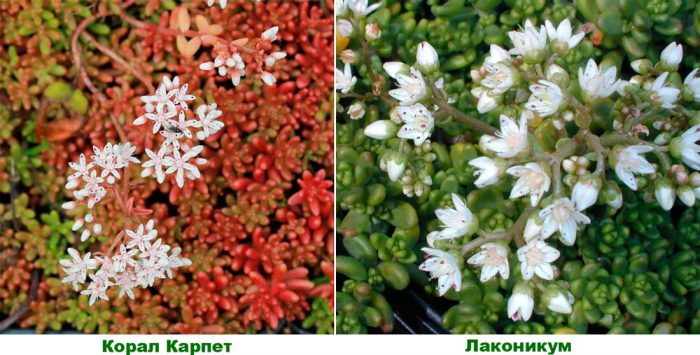

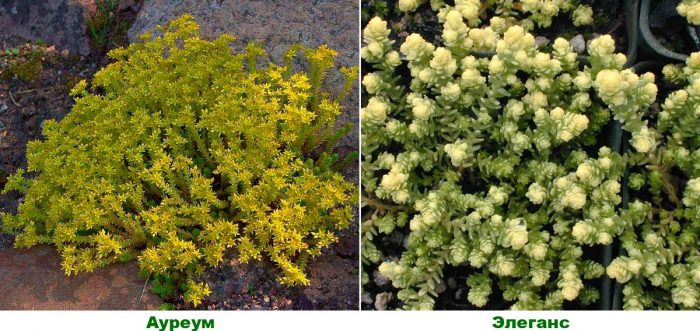
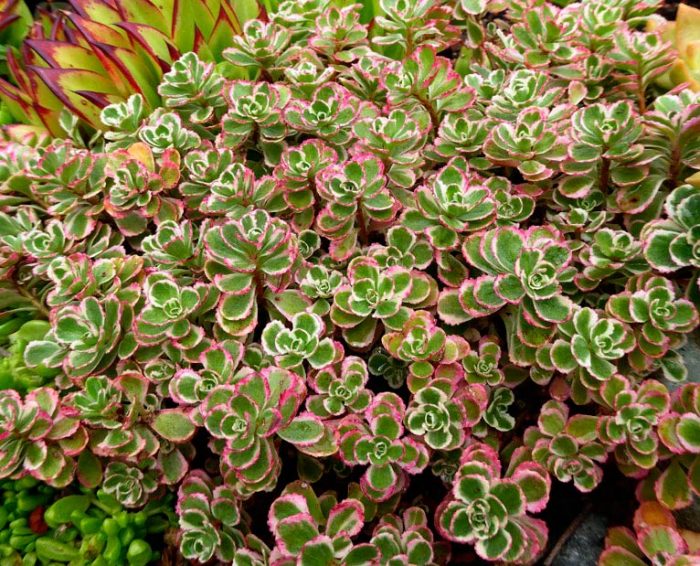
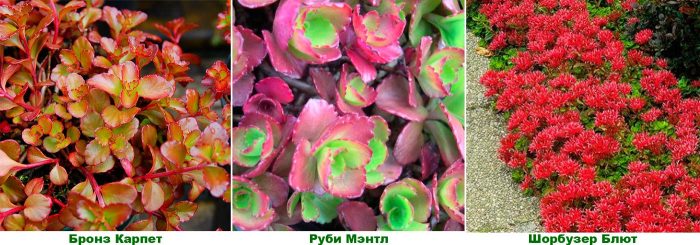
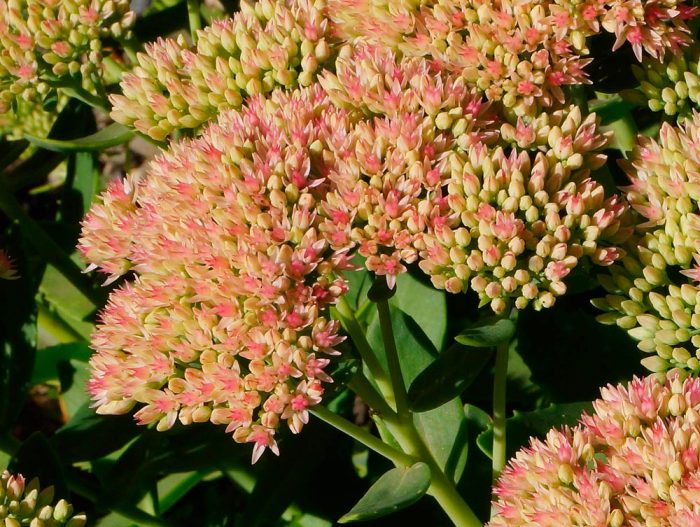


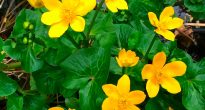





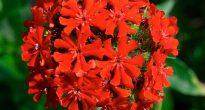



Can sedum be brewed with green tea? And how many leaves to eat without harm to health?